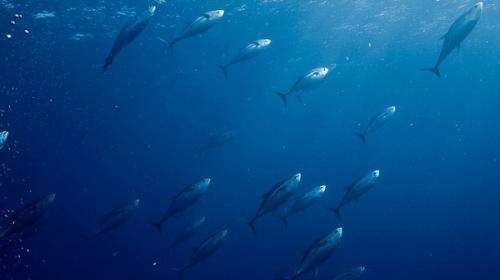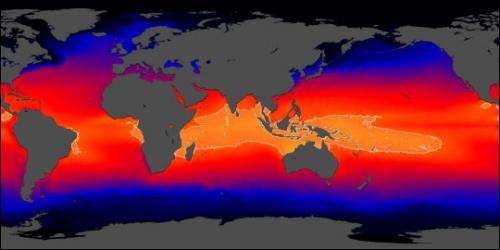Skipjack tuna fare better under high-res model

Refuting lower-resolution results, high-resolution ocean modelling has predicted climate change will have little impact on western Pacific tuna fisheries in the 2060s.
Skipjack tuna fisheries in the western Pacific warm pool will not be drastically impacted by climate change in the next 50 years, according to projections with an ocean model that divides the ocean into a high-resolution 10km grid.
Adapted for Australian oceans, the model simulates the effect of climate in the 2060s on temperature and currents in the warm pool, a tuna habitat defined by warmer surface water. Tuna fisheries in the warm pool are vital to many Pacific Island nations.
The high-resolution projections differ from lower-resolution results that forecast climate change would cause reduced phytoplankton and dwindling tuna. Instead, the new model predicts fluctuations in phytoplankton distribution and concentration will balance out, resulting in little to no change for skipjack tuna fisheries.
"Most of the models we use have coarse resolution," says CSIRO's Ming Feng, WA-based oceanographer and paper co-author.
"They use a 100km grid, so they don't resolve boundary currents and eddies."
But Dr Feng says smaller ocean features support much of the ocean's food chain.

"If your model cannot simulate these kinds of features then it won't give you a realistic simulation of primary production," says Dr Feng.
Where lower-resolution models blur the effect of zonal currents and often misrepresent the warm pool's boundaries, the higher-resolution model allows more detailed projections.
"The model suggests the size of the tuna habitat won't change, but it does show an eastward expansion of the warm pool," says Dr Feng.
"That may have implications for feeding behaviour and other behaviours we haven't captured yet."
To learn more about the effect of climate change on tuna fisheries, the team hopes to add an ecological model to the mix.
"It's all standing on giant's shoulders," says CSIRO's Chaojiao Sun.
"Our models and data come from other people's research, and we synthesise all the available data."
The ocean model, developed by the US National Oceanic and Atmospheric Administration, was adapted by CSIRO for use in Australian oceans and has since been updated for global high-resolution.
It was overlaid with a biogeochemistry model developed by the CSIRO Hobart team, and results were analysed using research data on tuna habitat.
Computing just one year of the simulation takes around four days, says Dr Sun, even using the supercomputer at Australia's National Computational Infrastructure.
"If you want to run a hundred-year simulation, you have to multiply that by a hundred. I've gained a few grey hairs."
Provided by Science Network WA


















